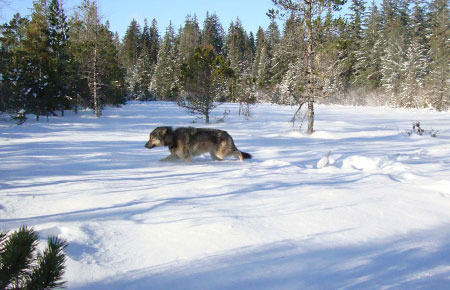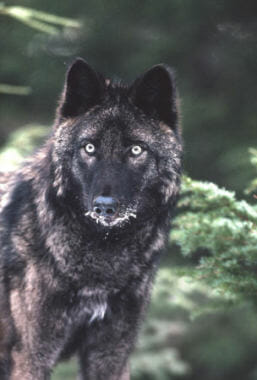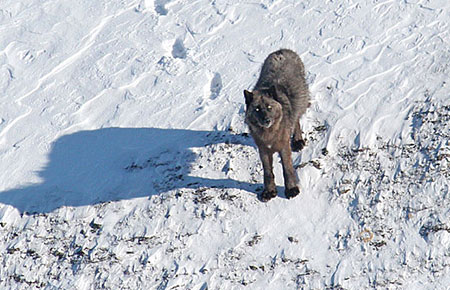
A wolf near Gustavus. (Photo courtesy Alaska Department of Fish and Game)
Carl Koch remembers one of his first encounters with a wolf just after he arrived in Alaska in 2007. Koch and his wife were out on Mendenhall Lake cross-country skiing with his two dogs when a black wolf started following them.
“I encountered that wolf several times out by the (Mendenhall) glacier,” Koch said. “I couldn’t believe this. The wolf was trying to follow me and the dogs while I was skiing. We’d bang the ski poles to get it to go away. But we had lots of reports back then of at least some folks feeding it.”
Koch said once animals become food conditioned and learn that people mean food, they become more comfortable hanging around.
That black wolf may have been the same one that became habituated to pet dogs, humans and human food. It was eventually shot by a poacher.
“It’s always cool to see a wolf, and it’s great to see animals that are wild to behave like wild animals,” Koch said. “But when they start behaving habituated, it can – as we saw in that situation – end up bad for the animal for sure.”
It’s rare for wolves to attack humans.
Only two fatalities have been recorded in North America: the first was reported outside of Ontario in 2005, and the last occurred in 2010 in Alaska when a Chignik Lake schoolteacher was reportedly chased down by two wolves.
“We can control our actions and we can’t control the actions of the wildlife,” Koch said. “But, when it comes to wolves specifically, we get fewer reports of them because they are very reclusive and they try (to) avoid humans. And so, just a few reports and it gets all over social media and people get pretty excited.”

Koch is now an assistant area management biologist for the Alaska Department of Fish and Game.
Koch has a list of things for hikers, cross-country skiers, and other outdoor enthusiasts to be wolf aware.
For anyone who lives in bear country, the list sounds pretty similar.
“While you’re out and about, just be aware of your surroundings,” Koch said. “Negative encounters with wolves are pretty rare. They are canids, so they will defend their territory to other wolves, and sometimes they can react that way to dogs. So, just like bears, we recommend dog owners keep their dogs leashed. Certainly don’t feed them intentionally or accidentally. Don’t leave food outside.”
Koch also recommends taking care of attractants around the home, like securing garbage and any livestock, and bringing your pets inside overnight.
If you encounter a wolf, Koch warns against instilling what he calls “chase behavior.”
“Don’t run and don’t turn your back,” Koch said. “Most often, I think they’re going to run away from us. But if (a wolf) does approach you, then you can escalate starting with human voice, picking up a rock. Things like that.”
Because wolves are so reclusive, Koch said there’s no good information on the area’s wolf population. But he says they do have harvest data.
Three wolves were harvested in the Juneau and Douglas area last year. One wolf, so far, this year.
